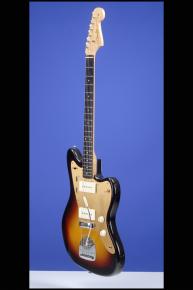The Original Jazzmaster with the Anodized Metal Pickguard…
One of the earliest Jazzmasters with a gold anodized guard, this guitar weighs just 7.90 lbs. and has a nut width of just under 1 11/16 inches and a scale length of 25 1/2 inches. Solid alder body, maple neck, and slab rosewood fretboard with 21 frets and inlaid clay dot position markers. Headstock with decal with Fender "spaghetti" logo in gold with black trim, "Jazzmaster" in black beside it, and "With Synchronized Floating Tremolo" in black below it. "Offset Contour Body Pat. Pending" decal at the ball end of the headstock. Single "butterfly" string tree. Individual single-line Kluson Deluxe tuners with oval metal buttons (stamped on the inside "D-169400/PATENT NO"). Four-bolt neck plate with serial number ("31120") between the top two screws. Two Jazzmaster pickups (large white rectangular six-polepiece pickups) with outputs of 8.09k and 7.91k. Original gold anodized metal pickguard with nine screws. Two controls (master volume, master tone) with white plastic knobs plus three-way selector switch and jack socket on the treble side of the pickguard, two roller knobs (one volume, one tone) plus two-way slide switch on the bass side of the pickguard. Jazzmaster bridge and integrated tailpiece and tremolo. The thick slab Brazilian rosewood fretboard is in great shape and the original frets show remarkably little wear (a rhythm guitarist must have owned this one!). Inside the guitar, the solder joints are untouched, as is all of the wiring, and as are all of the small pieces of white tape used by the original assembler. The 'lead circuit' potentiometers are dated "137 850" and "137 906" (CTS December 1958 and February 1959), the 'rhythm circuit potentiometers are dated "304 904" (Stackpole January 1959), and the neck is dated in pencil "1-59". This is one of the finest gold anodized guard Jazzmasters that we have ever seen. This wonderful Forty-eight year old beauty is in exceptionally fine (9.00) condition with just a few tiny surface chips on the edges. Complete with the original bridge cover and tremolo arm. Housed in its original Fender "tweed" hardshell case with orange plush lining (9.00).
This is just like the one that we purchased at the Eric Clapton Crossroads auction (serial # 32808)… that guitar was Lot 72 in the 24 June 2004 Christie's New York sale of Eric Clapton's guitars. "Beautiful. I had one of these in the Yardbirds, with a tortoiseshell effect scratchplate. It was a nostalgic buy, I got it for the look of the guitar as much as anything… beautiful shaped body design, just pure…" (Eric Clapton, quoted in the sale catalogue). "This one's a particularly nice example. I seem to remember you got it just after the George Harrison Tour in Japan (November/December 1991)" (Lee Dickson, quoted).
The most notable thing about Jazzmasters from 1958 to the summer of 1959 is the anodized metal pickguard. It is amazingly thick, at about .100 of an inch, which provides good looks, as well as shielding. Unfortunately, in the summer of 1959, Fender changed to a tortoiseshell/white/black/white celluloid pickguard (except on certain custom color Jazzmasters, which had white/black/white celluloid pickguards). We are not sure why this change was made, although the celluloid pickguards did wear better. Every one of the gold anodized pickguards we have seen has had the usual large wear spot in the middle. This exceptional guitar is the true exception! The pickguard is totally original and unmarked.
"The Jazzmaster first appeared in Fender sales material during 1958, and at some $50 more than the Strat it became the new top-of-the-line model...Immediately striking to the electric guitarist of 1958 was the Jazzmaster's unusual offset-waist body shape...For the first time on a Fender, the Jazzmaster featured a separate rosewood fingerboard glued to the customary maple neck...The Jazzmaster's floating vibrato system was new, too, and had a tricky 'lock-off' facility aimed at preventing tuning problems if a string should break. The controls were certainly elaborate for the time…A small slide-switch selected between two individual circuits, offering player-preset rhythm and lead sounds. The idea was a good one: the ability to set up a rhythm sound and a lead sound, and switch between them. But the system seemed over-complicated to players brought up on straightforward volume and tone controls. The sound of the Jazzmaster was richer and warmer than players were used to from Fender. The name Jazzmaster had not been chosen at random, for Fender was aiming this different tone at jazz players, who at the time largely preferred hollowbody electrics, and principally those by Gibson. However, jazz guitarists found little appeal in this new, rather difficult solidbody guitar -- and mainstream Fender players largely stayed with their Stratocasters and Telecasters" (Tony Bacon, 50 Years of Fender, p. 26). Much to Fender's surprise, however, the Jazzmaster turned into the best surf guitar ever conceived.
Translate:









